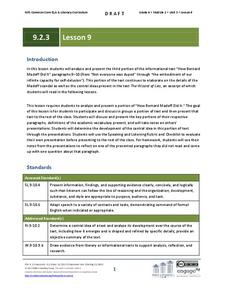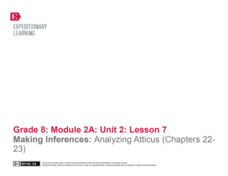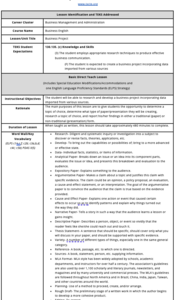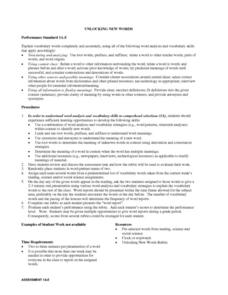EngageNY
Grade 9 ELA Module 1: Unit 3, Lesson 16
"Thus, with a kiss, I die." After viewing a film clip of the events leading up to Romeo's suicide, class members analyze Act 5, scene 3, lines 88-120, in which Romeo drinks the apothecary's poison.
EngageNY
Grade 9 ELA Module 1: Unit 3, Lesson 17
Romeo and Juliet, Act 5, Scene 3, lines 139-170, is the focus of this day's lesson plan. Readers examine the dramatic irony in Juliet's comments and consider how "lamentable chance" caused by a "greater power" plays a role in the tragedy.
EngageNY
Grade 9 ELA Module 1: Unit 3, Lesson 18
Why is Romeo and Juliet considered a tragedy? Class members conclude their reading of the play, focusing on the final lines of Act 5, scene 3. They also consider how Shakespeare structures the text, orders events, and manipulates time to...
EngageNY
Grade 9 ELA Module 2, Unit 3, Lesson 9
Are we interested in crime stories because we either identify with the victims or enjoy watching the rich suffer? Do we feel guilty and want someone to take our blame and let us feel innocent? Groups investigate how the author of "How...
EngageNY
Grade 11 ELA Module 2: Unit 2, Lesson 11
In Audre Lorde's poem "From the House of Yemanjá," the speaker describes her mother's two faces, adding a whole new meaning to the phrase "two-faced." Pupils first read the final stanza of the contemporary poem. With a Quick Write, they...
EngageNY
Central Idea and Supporting Details: “Equal Rights for Women”
It's my right, not a privilege! Scholars review the details of the claims in the speech "Equal Rights for Women." They meet with one of their discussion appointments from a previous instructional activity to locate evidence to support...
EngageNY
Making Inferences: Analyzing Atticus (Chapters 22- 23)
What's the verdict? Scholars look closely at the reactions of various characters in To Kill A Mockingbird in the aftermath of the verdict. They circulate the room, responding to a variety of probing questions. Pupils finalize their...
EngageNY
Analyzing the Author’s Perspective: “The Shakespeare Shakedown”
Simon Schama's article "The Shakespeare Shakedown" allows young writers to see how authors respond to conflicting viewpoints. Class members participate in discussion appointments with five peers to explore the author's point of view.
EngageNY
Studying Conflicting Information: Varying Perspectives on the Pearl Harbor Attack, Part 2
Scholars take another look at Japan's Fourteen-Part Message. They then take turns adding ideas to sentence starters to create ideas about the different perspectives of government. To finish, groups mix and mingle to share their sentences...
EngageNY
Mid-Unit Assessment: Gathering and Using Evidence to Analyze Points of View in A Long Walk to Water (Chapter 5)
Class members discuss how culture, place, and time influence a character's identity in A Long Walk to Water by Linda Sue Park. Then, as part of a mid-unit assessment, they complete a Gathering Evidence graphic organizer to answer the...
Texas Education Agency (TEA)
Business Project
Where's the data? After choosing from a list of business topics, scholars embark on a research project. They develop a strong thesis statement, follow MLA formatting requirements, select sources, and write a five-paragraph research...
EngageNY
Conducting Research: Analyzing Expert Texts about the Mary River Project
Pupils read informational texts about the Mary River Project, searching for the gist. As they read the expert texts, they complete a graphic organizer to identify and analyze point of view.
Humanities Texas
Primary Source Worksheet: George Washington, Farewell Address
Invite your young historians to consider how the first president of the United States envisioned the future of the new nation with this primary source analysis worksheet on George Washington's Farewell Address.
Curated OER
Letter Recognition Flash Games for Kids
Young scholars explore the alphabet by completing an on-line letter identification activity. For this phonetics lesson, students utilize the website www.literarycenter.net and listen to word sounds as they identify the spelling of the...
Curated OER
Spelling Word Search 2
For this literacy worksheet, students find the words that are associated with the acquisition of new vocabulary and the answers are found at the bottom of the page.
Curated OER
Spelling Word Search
In this literacy activity, students find the words that are associated with the acquisition of new vocabulary and the answers are found at the bottom of the page.
Curated OER
Space; Vocabulary Review
In this science worksheet, students locate 25 vocabulary words in a word search. The words all relate to the study of space and space exploration.
Curated OER
FGB Word Search
In this literacy worksheet, students find the words that are related to further vocabulary acquisition and the answers are found by clicking the button at the bottom of the page.
Curated OER
Chandra Word Search
In this space science worksheet, students find the words that are associated with learning new vocabulary and the answers are found by clicking the link at the bottom of the page.
Curated OER
Moby Dick Word Search
In this Moby Dick word search, learners identify terms that are found in the book. A list of approximately 70 vocabulary words is provided. An answer sheet is available.
Curated OER
Spanish Words
In this Spanish worksheet, students identify and locate Spanish vocabulary words, numbers, and colors. There are 24 words located in the puzzle.
Curated OER
Unlocking New Words
Students are introduced to the various types of suffixes and prefixes. In groups, they identify the root words and determine the proper suffix or prefix to add to the root. They complete a worksheet and review their answers to end the...
Curated OER
Batter Up
Students explore personal achievement by reading a children's book. In this story analysis lesson, students read the book Batter Up, by Sue Muller Hacking and discuss the main character in the story and the actions that she takes to meet...
Curated OER
Greek, Latin and Anglo-Saxon Roots to Better Vocabulary
Seventh graders review the concepts of affixes and roots. They practice common Greek, Latin, and Anglo-Saxon ones which are used to form many words in English. Students develop an awareness of the formation and evolution of words.























